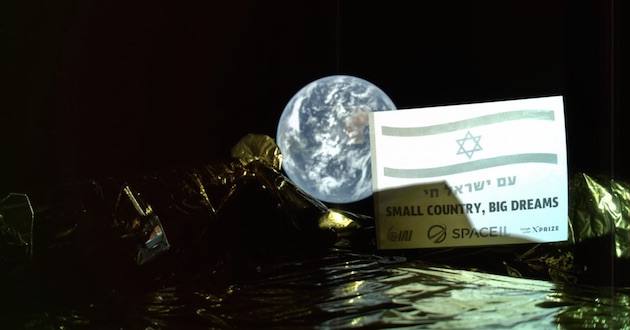Israel’s Beresheet historic Moon landing spacecraft sent back its first image from more than 20,000 miles above the earth.
The spacecraft, which is the first one Israel has sent to the moon and only the fourth country in the world to do so, took a picture with its “selfie camera” and sent it back to scientists on the ground Tuesday.
Australia is clearly seen in the image, along with a small sign installed on the front of the spacecraft with the message “Am Yisrael Chai” (The People of Israel Live) and an Israeli flag.
“The selfie of the spacecraft is proof of the technological power of Israel,” said the Israeli Minister of Science and Technology Ofir Akunis, according to The Jerusalem Post. “Despite the small size of the spacecraft Beresheet, it brings us great joy. The spacecraft is proof of the technological strength and power of Israel, and its success passes on an educational message as well to the children of Israel: You need to dream big,” he said.
Eran Schmidt, Deputy Project Manager of SpaceIL and Head of Ground Operations says, like any space mission, challenges present themselves for a successful completion.
Schmidt stressed that the major challenges still lie ahead of the April 11 scheduled landing, specifically a process known as “lunar capture.” During this phase, Beresheet will be pulled into the moon’s orbit by its gravity. This is expected to take place in early April and requires “perfect timing and positioning” roughly 250,000 miles away, according to Schmidt.
“The landing itself is a huge, huge test,” he elaborated. “We are going to send a command to the spacecraft to start [descending] and afterwards we will have 20 minutes when everything will work autonomously. So we need the sensor measurements to be good, the control system to act properly and we hope that we will not land in the middle of a crater on a rock. We are not in a position to forego the landing if we see something is not working correctly.”
Tal Inbar, an Israeli space expert, also highlighted “lunar capture” as a crucial technical test and agreed that other milestones must be surpassed.
“Each part of a space mission has its own challenges and difficulties,” Inbar told The Media Line. “Each day that the space craft moves towards the moon, the dosage of radiation from the sun and from cosmic [sources] is higher and higher. After a successful landing, the main challenge will be the heat. The spacecraft won’t [be operational] for long on the surface of the moon because it was not built to withstand the extreme temperatures there.”
If Israel is successful, it will become the fourth country to make it to the moon, after the US, Russia, and China.
 Metro Voice News Celebrating Faith, Family & Community
Metro Voice News Celebrating Faith, Family & Community 








